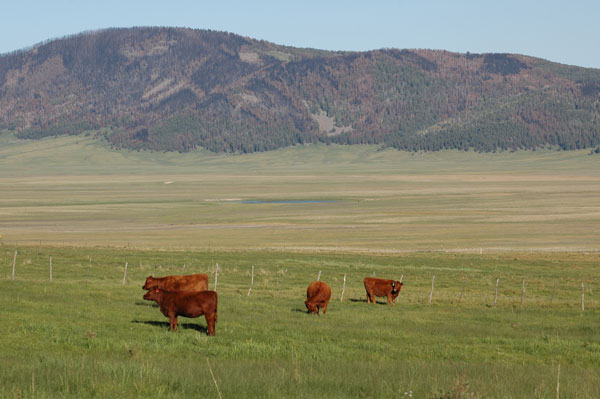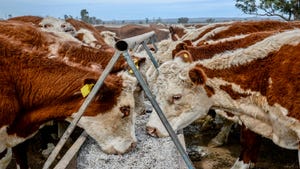Can New Tools Help Identify Environmentally Fit Cattle For High Altitudes?
How can ranchers better predict which cattle are likely to develop pulmonary hypertension so that health problems might be averted?
April 2, 2012

It’s well known that many beef cattle living at high altitudes are afflicted with pulmonary hypertension, or high blood pressure in the arteries of the lungs, and that these animals are at risk of dying from congestive heart failure if they are not moved to lower altitudes and medically treated. The health issue is commonly called brisket disease because fluid often collects in the lower chest cavities of cattle affected, swelling the brisket area.
The big question is: How can ranchers better predict which cattle are likely to develop the disease so that health problems might be averted?
Milton Thomas, a new professor in Colorado State University’s Department of Animal Sciences, hopes to help provide an answer. Thomas is leading research aimed at vastly improving data-based tools used to predict whether an animal or its offspring might develop brisket disease.
“This research puts us right at the cutting edge of science,” said Thomas, who joined the faculty in December to fill the John E. Rouse Chair of Animal Breeding and Genetics. “With this work, we are addressing real problems while building basic science.”
Brisket disease strikes as many as 5 percent of cattle living at or above 6,500 feet elevation, according to the Merck Veterinary Manual, and scientists say it has been observed in cattle at elevations as low as 5,000 feet. That describes much of the West’s traditional cattle terrain.
Thomas and his colleagues in CSU’s Beef Cattle Breeding and Genetics Program are gleaning information from the bovine genome, which was fully sequenced in 2004, to develop a new type of data-based tool that would more accurately forecast the likely inheritance of brisket disease.
This genomics approach to disease prediction – taking into account an entire set of genetic information – would create a new type of Expected Progeny Difference (EPD) data that would draw upon information about an animal’s genome as well as measurements of heart and lung health from individual animals.
Cattle producers would use these tools when making breeding and buying decisions, much as they now consider EPDs to predict calving ease, growth rates and other inherited traits.
The project reflects a focus in the College of Agricultural Sciences on supporting beef-cattle production that is both profitable and environmentally sound. The Beef Cattle Breeding and Genetics Program is made up of 10 faculty, research associates and graduate students.
Cattle producers now rely on pulmonary arterial pressure (PAP) scores, derived from right heart catheterization tests, to identify animals predisposed to brisket disease. The problem is, the scores are not always reliable.
Additionally, ranchers monitor their herds for brisket disease; if a bull or cow develops the problem, the animal often is not retained for herd development, nor is it sold at a seedstock premium. Rather, it typically is sent to slaughter to avoid propagating the disease that tends to run in cattle families.
“That kind of ruthless culling is a hard way to avoid brisket disease. If we have genetic tools to help us get there – to tell us who can tolerate higher altitudes and who can’t – then we don’t have to go through that time and horrendous expense of the culling process,” Thomas said.
He and his colleagues hope to help ranchers build herds that are more environmentally fit. It would be significant progress, given the incidence of brisket disease.
To conduct their research, Thomas and his colleagues in the Beef Cattle Breeding and Genetics Program rely on a herd of some 425 Angus cow-calf pairs at One Bar Eleven Ranch. The ranch, spanning 7,500 acres near Saratoga, Wyo., is home to the CSU John E. Rouse Beef Improvement Center.
CSU has long and productive ties to the ranch and to the Rouse family. In 1986, John E. Rouse, a former Standard Oil executive and longtime cattleman, gave his Angus cattle ranch to CSU’s Department of Animal Sciences. The ranch would be managed as a working cattle operation that would contribute to research aimed at understanding and improving genetics of high-elevation beef herds, ultimately promoting profitability for ranchers.
In 2009, Rouse’s grandchildren, Steve Schalk, Claudia Short and Karen Schalk, bought the ranch from CSU, bringing it back into their family. The transaction allowed the university to lease back the ranch from the family and to create the John E. Rouse Chair in Animal Breeding and Genetics, held by Thomas.
The result: With the generosity of the Schalk and Short families, the CSU John E. Rouse Beef Improvement Center continues to operate as a critical teaching and beef-cattle research facility – and CSU’s Beef Cattle Breeding and Genetics Program has been augmented with a talented professor.
“With the addition of Dr. Thomas to our Beef Cattle Breeding and Genetics Program, CSU will continue to advance in an area of teaching and research excellence,” said Kevin Pond, head of the Department of Animal Sciences. “We are extremely grateful to the family of John Rouse. Their generosity is maintaining a ranch that’s critical for beef-cattle teaching and research, while also boosting the CSU team doing that work.
“This is a tremendous partnership that will truly benefit the industry by helping us to train students and create new knowledge.”
The focus for the Beef Improvement Center breeding program is to continue developing the ranch’s herd of Angus cattle with emphasis on fertility, maternal ability, low pulmonary arterial pressure, strong early growth and excellent carcass quality.
The CSU beef team hopes to assist the agricultural industry by training students at the ranch, by selling cattle well-adapted to their environment, and by presenting science-based solutions based on research with the herd.
You May Also Like



